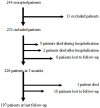Cerebral Venous Thrombosis: Clinical, Radiological, Biological, and Etiological Characteristics of a French Prospective Cohort (FPCCVT)-Comparison With ISCVT Cohort
- PMID: 34819911
- PMCID: PMC8606816
- DOI: 10.3389/fneur.2021.753110
Cerebral Venous Thrombosis: Clinical, Radiological, Biological, and Etiological Characteristics of a French Prospective Cohort (FPCCVT)-Comparison With ISCVT Cohort
Abstract
Introduction: Cerebral venous thrombosis (CVT) is a rare disease with highly variable clinical presentation and outcome. Etiological assessment may be negative. The clinical and radiological presentation and evolution can be highly variable. The mechanisms involved in this variability remain unknown. Objective: The aim of this multicenter French study registered on ClinicalTrials.gov (NCT02013635) was therefore to prospectively recruit a cohort of patients with cerebral venous thrombosis (FPCCVT) in order to study thrombin generation and clot degradation, and to evaluate their influence on clinical radiological characteristics. The first part of the study was to compare our cohort with a reference cohort. Methods: This prospective, multicenter, French study was conducted from July 2011 to September 2016. Consecutive patients (aged >15 years) referred to the stroke units of 21 French centers and who had a diagnosis of symptomatic CVT were included. All patients gave their written informed consent. The diagnosis of CVT had to be confirmed by imaging. Clinical, radiological, biological, and etiological characteristics were recorded at baseline, at acute phase, at 3 months and at last follow-up visit. Thrombophilia screening and the choice of treatment were performed by the attending physician. All data were compared with data from the International Study on CVT published by Ferro et al. Results: Two hundred thirty-one patients were included: 117 (50.6%) had isolated intracranial hypertension, 96 (41.5%) had focal syndrome. During hospitalization, 229 (99.1%) patients received anticoagulant treatment. Median length of hospital stay was 10 days. Five patients died during hospitalization (2.2%). At 3 months, 216 patients (97.0%) had follow-up with neurological data based on an outpatient visit. The mean duration of antithrombotic treatment was 9 months, and the mean time to last follow-up was 10.5 months. At the end of follow-up, eight patients had died, and 26 patients were lost to follow-up. At least one risk factor was identified in 200 patients. Conclusions: We demonstrated that the FPCCVT cohort had radiological, biological, and etiological characteristics similar to the historical ISCVT cohort. Nevertheless, the initial clinical presentation was less severe in our study probably due to an improvement in diagnostic methods between the two studies.
Keywords: French cohort; cerebral veins; prospective observational study; sinus; thrombosis.
Copyright © 2021 Triquenot Bagan, Crassard, Drouet, Barbieux-Guillot, Marlu, Robinet-Borgomino, Morange, Wolff, Grunebaum, Klapczynski, André-Kerneis, Pico, Martin-Bastenaire, Ellie, Menard, Rouanet, Freyburger, Godenèche, Allano, Moulin, Mourey, Derex, Berruyer, Runavot, Trichet, Viader, Le Querrec, Husein, Cluet-Dennetiere, Macian-Montoro, Donnard, Guillon, Ternisien, Zuber, Laplanche, Tassan, Peeltier, Canaple, Roussel, Gaillard, Scavazza and Le Cam Duchez.
Conflict of interest statement
The authors declare that the research was conducted in the absence of any commercial or financial relationships that could be construed as a potential conflict of interest.
Similar articles
-
Venous Thrombotic Recurrence After Cerebral Venous Thrombosis: A Long-Term Follow-Up Study.Stroke. 2017 Feb;48(2):321-326. doi: 10.1161/STROKEAHA.116.015294. Epub 2016 Dec 15. Stroke. 2017. PMID: 27980127
-
Direct Oral Anticoagulants for the Treatment of Cerebral Venous Thrombosis.Cerebrovasc Dis. 2019;48(1-2):32-37. doi: 10.1159/000502454. Epub 2019 Sep 3. Cerebrovasc Dis. 2019. PMID: 31480062
-
Prognosis of cerebral vein and dural sinus thrombosis: results of the International Study on Cerebral Vein and Dural Sinus Thrombosis (ISCVT).Stroke. 2004 Mar;35(3):664-70. doi: 10.1161/01.STR.0000117571.76197.26. Epub 2004 Feb 19. Stroke. 2004. PMID: 14976332
-
Cerebral venous thrombosis in Argentina: clinical presentation, predisposing factors, outcomes and literature review.J Stroke Cerebrovasc Dis. 2020 Oct;29(10):105145. doi: 10.1016/j.jstrokecerebrovasdis.2020.105145. Epub 2020 Jul 28. J Stroke Cerebrovasc Dis. 2020. PMID: 32912503 Review.
-
Recanalization in Cerebral Venous Thrombosis.Stroke. 2018 Aug;49(8):1828-1835. doi: 10.1161/STROKEAHA.118.022129. Stroke. 2018. PMID: 30021808
Cited by
-
The Burden of Cerebral Venous Thrombosis in a Romanian Population across a 5-Year Period.Life (Basel). 2022 Nov 9;12(11):1825. doi: 10.3390/life12111825. Life (Basel). 2022. PMID: 36362980 Free PMC article.
-
Safety and clinical outcomes in endovascular treatment for symptomatic cerebral venous thrombosis: a single-center experience with meta-analysis.Neurosurg Rev. 2023 May 10;46(1):114. doi: 10.1007/s10143-023-02012-5. Neurosurg Rev. 2023. PMID: 37160781
-
Cerebral Venous Thrombosis and Nitrous Oxide Intoxication: Report of Two Cases and Review of the Literature.Brain Behav. 2025 Mar;15(3):e70394. doi: 10.1002/brb3.70394. Brain Behav. 2025. PMID: 40022289 Free PMC article. Review.
-
Inflammation and Severe Cerebral Venous Thrombosis.Front Neurol. 2022 Jul 22;13:873802. doi: 10.3389/fneur.2022.873802. eCollection 2022. Front Neurol. 2022. PMID: 35937062 Free PMC article. Review.
-
Outcome of Cerebral Venous Thrombosis Requiring Mechanical Ventilation.J Clin Med. 2025 Apr 24;14(9):2930. doi: 10.3390/jcm14092930. J Clin Med. 2025. PMID: 40363962 Free PMC article.
References
Associated data
LinkOut - more resources
Full Text Sources
Medical


